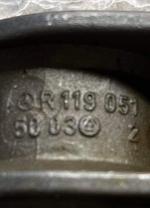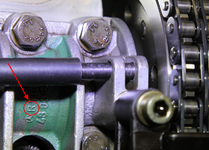Probably a really dumb question but how on earth do you search for a part number and find the correct part when using the term "Hose"?
There must be hundreds of part numbers with generic descriptions like that.
Yeah, the descriptions are generally awful. Look up the part in the EPC and get the part number, ignore the descriptions online.
I know you can search for character 1-3 and 4-6 of a VIN but where is the detail to know which hose is which? It's ok if you have the broken part on hand and can read the part number.
Sometimes the EPC diagrams are clear, other times not so much. For generic items like tubing or rubber grommets, there may just be a chart showing various items, and you pick the correct one from the choices shown, like this one:

For example, I was looking for this part number recently and tried R119 051 50 03:
That is a cam bearing cap, which is a casting and part of a larger assembly (cylinder head). Casting numbers are often NOT the same as replacement part numbers! This is especially true with casting numbers for blocks, heads, differentials, transmissions, steering gearboxes.
However, for this cam bearing cap, the number stamped into the part is actually the replacement part number... but with an "A" prefix, not "R". Ignore the "R". The letter prefix can
almost always be ignored and is
almost never required when searching online.
Managed to find something by dropping the R but the part I found was actually A1190515003 - no spaces:
© PART SOUTH 2013. PART SOUTH will be responsible only for "the products sold by us". No exceptions! We want to have the opportunity to make it right with you. Failure to do so may delay the processing of your order.
www.ebay.com
Spaces are shown in the EPC part number, but searching with spaces often "breaks" search engines, including online dealer part sites. Searching with hyphens generally works fine, and is easier to read than the number without spaces. This is why GSXR almost always posts part numbers with hyphens instead of spaces, i.e.
119-051-50-03. If a part number is posted on a forum thread with spaces, you almost always have to delete the spaces before copy / paste and then searching - extra work that gets annoying.
I can't believe it is too difficult for MB to have a website where you enter your VIN and it lists every part you can buy.
That's the EPC. Enter your VIN and it will list every part you can buy, just not in a big text file, you have to navigate by group / subgroup / callout. And it's only 95-98% accurate. And not every part you want is sold separately. Or still available.
Also, what is the nomenclature for MB part numbers?
See below from EPC documentation:
The Mercedes-Benz Parts Numbering System
Each Mercedes-Benz spare part is assigned an identification number,
used for ordering the part. These part numbers follow an ordered system,
as the following:
1-Basic Numbering
2-Sorting order
3-Letter prefixes
4-Suffix Numbers
Lets swim to little details about each.
1-Basic Numbering
The most common part number has 10 digits and a letter prefix “A”. Such a part number is written as follows:
A 117 030 10 17
Note the spacing and grouping of the digits. When spoken, you say it as it’s written, like “A- one-seventeen, oh-thirty, ten, seventeen”. Most people used to MB part numbers will say it that way, and saying it differently tends to confuse.
Each section has a distinct meaning:
A Prefix for Passenger Car parts. Other prefixes (such as B, C, N and W) are explained below.
117 Type Number – This is the internal type designation indicating which vehicle type for which this part was first designed. Parts may be (and often are) used in other types. Some parts use other numbers unrelated to model types.
030 The parts group number. Major group 03 corresponds to the EPC group to which the part generally belongs. The third digit indicates (broadly) the type of part from that group.
10 Modification Number. This identifies the modification status or variant of the part. The first version or variant is generally numbered 00, and numbers increase with new variants. A higher number does not necessarily mean the part is newer or better, it is assigned somewhat randomly and not all numbers are assigned or used in strict sequence.
17 Part Type. Most similar parts of a certain type have the same type number. In this case, part type 17 (in group 030) is a Piston.
2-Sorting order
When sorting a list of 10 digit part numbers, use the order shown:
A 117 030 10 17 will be sorted in the following order
117 will be Third
030 will be First
10 will be Fourth (last)
17 will be Second
For example, first put all part numbers in order of the second group of digits (030), then sort within the group by type (17), then by Type number within Type (117), and last by Modification Number.
That makes Sense!
All other part prefixes (such as N or B) are sorted in direct numerical order.
Examples of the spacing and grouping of part numbers with other prefxies are:
B6 782 0415
BQ682 0116
HWA202 545 27 19
N004019 013802
W210 589 03 29 00
3-Letter prefixes
Use of the correct letter prefix is essential. While most parts are numbered uniquely, some may be duplicated with different letter prefixes.
The map to the treasure:
A Passenger car parts
B Accessory parts
BQ MBUSA Domestically-assigned part numbers
C Commercial vehicle parts
HWA Special passenger car parts (generally AMG)
N DIN (German Industry Standard) parts
Q Not a valid part, used as a placeholder in some EPC catalogs. Usually 12 digits, often all zeros. Do not confuse with BQ part numbers.
W Special tools
X Some commercial vehicle & light truck parts
4-Suffix Numbers
There are two kinds of suffix number, known as ES1 and ES2. A part generally uses only one or the other, but both may be used for a single number. ES is an abbreviation for the German words Erganzungs Schluessel, which translate as “Supplemental Key”.(See learning Dutch is easy )
)
ES1 codes are always two digits, and always immediately follow the base part number. The ES1 is sometimes called an “Index” number in the literature. Some ES1 numbers can be used to designate a specific version of a base number, such as for Pistons or Springs, which can be supplied with slightly different sizes or values. The meaning of some common ES1 codes is as follows:
05 Special demand part. Often used to denote parts supplied for a service action
10-15 Package sizes for a base number. Often used for service fluids
26-28 Component that is pre-programmed or specially prepared
64-69 A part identical to the base number, but from a different supplier or location
70 A core with value which should be returned for credit
80 A remanufactured component, which also has a core value.
81 A remanufactured component, which does not have any core value.
87, 88 Same as 80
90 A remanufactured part with no core value, often used for Warranty repairs
ES2 codes are always four characters, with digits and letters often mixed. These are always placed at the end of the entire part number, after the ES1 number if necessary. These are most commonly used to denote the color and texture of specific parts which are supplied in different colors and/or extures. The correct ES2 code must be specified to receive the correct part. These are sometimes called “Color Codes”, not to be confused with paint and trim color codes. Some parts have an ES2 code of 9999, which generally means that the part is provided in primer and must be painted.















